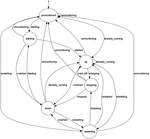kostya / Eye
Programming Languages
Labels
Projects that are alternatives of or similar to Eye
Eye
Process monitoring tool. Inspired from Bluepill and God. Requires Ruby(MRI) >= 1.9.3-p194. Uses Celluloid and Celluloid::IO.
Little demo, shows general commands and how chain works:
Installation:
$ gem install eye
Why?
We have used god and bluepill in production and always ran into bugs (segfaults, crashes, lost processes, kill not-related processes, load problems, deploy problems, ...)
We wanted something more robust and production stable.
We wanted the features of bluepill and god, with a few extras like chains, nested configuring, mask matching, easy debug configs
I hope we've succeeded, we're using eye in production and are quite happy.
Config example
examples/test.eye (more examples)
# load submodules, here just for example
Eye.load('./eye/*.rb')
# Eye self-configuration section
Eye.config do
logger '/tmp/eye.log'
end
# Adding application
Eye.application 'test' do
# All options inherits down to the config leafs.
# except `env`, which merging down
# uid "user_name" # run app as a user_name (optional) - available only on ruby >= 2.0
# gid "group_name" # run app as a group_name (optional) - available only on ruby >= 2.0
working_dir File.expand_path(File.join(File.dirname(__FILE__), %w[ processes ]))
stdall 'trash.log' # stdout,err logs for processes by default
env 'APP_ENV' => 'production' # global env for each processes
trigger :flapping, times: 10, within: 1.minute, retry_in: 10.minutes
check :cpu, every: 10.seconds, below: 100, times: 3 # global check for all processes
group 'samples' do
chain grace: 5.seconds # chained start-restart with 5s interval, one by one.
# eye daemonized process
process :sample1 do
pid_file '1.pid' # pid_path will be expanded with the working_dir
start_command 'ruby ./sample.rb'
# when no stop_command or stop_signals, default stop is [:TERM, 0.5, :KILL]
# default `restart` command is `stop; start`
daemonize true
stdall 'sample1.log'
# ensure the CPU is below 30% at least 3 out of the last 5 times checked
check :cpu, below: 30, times: [3, 5]
end
# self daemonized process
process :sample2 do
pid_file '2.pid'
start_command 'ruby ./sample.rb -d --pid 2.pid --log sample2.log'
stop_command 'kill -9 {PID}'
# ensure the memory is below 300Mb the last 3 times checked
check :memory, every: 20.seconds, below: 300.megabytes, times: 3
end
end
# daemon with 3 children
process :forking do
pid_file 'forking.pid'
start_command 'ruby ./forking.rb start'
stop_command 'ruby forking.rb stop'
stdall 'forking.log'
start_timeout 10.seconds
stop_timeout 5.seconds
monitor_children do
restart_command 'kill -2 {PID}' # for this child process
check :memory, below: 300.megabytes, times: 3
end
end
# eventmachine process, daemonized with eye
process :event_machine do
pid_file 'em.pid'
start_command 'ruby em.rb'
stdout 'em.log'
daemonize true
stop_signals [:QUIT, 2.seconds, :KILL]
check :socket, addr: 'tcp://127.0.0.1:33221', every: 10.seconds, times: 2,
timeout: 1.second, send_data: 'ping', expect_data: /pong/
end
# thin process, self daemonized
process :thin do
pid_file 'thin.pid'
start_command 'bundle exec thin start -R thin.ru -p 33233 -d -l thin.log -P thin.pid'
stop_signals [:QUIT, 2.seconds, :TERM, 1.seconds, :KILL]
check :http, url: 'http://127.0.0.1:33233/hello', pattern: /World/,
every: 5.seconds, times: [2, 3], timeout: 1.second
end
end
Start eye daemon and/or load config:
$ eye l(oad) examples/test.eye
load folder with configs:
$ eye l examples/
$ eye l examples/*.rb
foreground load:
$ eye l CONF -f
If the eye daemon has already started and you call the load command, the config will be updated (into eye daemon). New objects(applications, groups, processes) will be added and monitored. Processes removed from the config will be removed (and stopped if the process has stop_on_delete true). Other objects will update their configs.
Two global configs loaded by default, if they exist (with the first eye load):
/etc/eye.conf
~/.eyeconfig
Process statuses:
$ eye i(nfo)
test
samples
sample1 ....................... up (21:52, 0%, 13Mb, <4107>)
sample2 ....................... up (21:52, 0%, 12Mb, <4142>)
event_machine ................... up (21:52, 3%, 26Mb, <4112>)
forking ......................... up (21:52, 0%, 41Mb, <4203>)
child-4206 .................... up (21:52, 0%, 41Mb, <4206>)
child-4211 .................... up (21:52, 0%, 41Mb, <4211>)
child-4214 .................... up (21:52, 0%, 41Mb, <4214>)
thin ............................ up (21:53, 2%, 54Mb, <4228>)
$ eye i -j # show info in JSON format
Commands:
start, stop, restart, delete, monitor, unmonitor
Command params (with restart for example):
$ eye r(estart) all
$ eye r test
$ eye r samples
$ eye r sample1
$ eye r sample*
$ eye r test:samples
$ eye r test:samples:sample1
$ eye r test:samples:sample*
$ eye r test:*sample*
Check config syntax:
$ eye c(heck) examples/test.eye
Config explain (for debug):
$ eye e(xplain) examples/test.eye
Log tracing (tail and grep):
$ eye t(race)
$ eye t test
$ eye t sample
Quit monitoring:
$ eye q(uit)
$ eye q -s # stop all processes and quit
Interactive info:
$ eye w(atch)
Process statuses history:
$ eye hi(story)
Eye daemon info:
$ eye x(info)
$ eye x -c # for show current config
Local Eye version LEye (like foreman):
Process states and events:
How to write Eye extensions, plugins, gems:
Eye-http Eye-rotate Eye-hipchat Plugin example
Thanks Bluepill for the nice config ideas.





